The 8 Scariest Nuns In Horror History
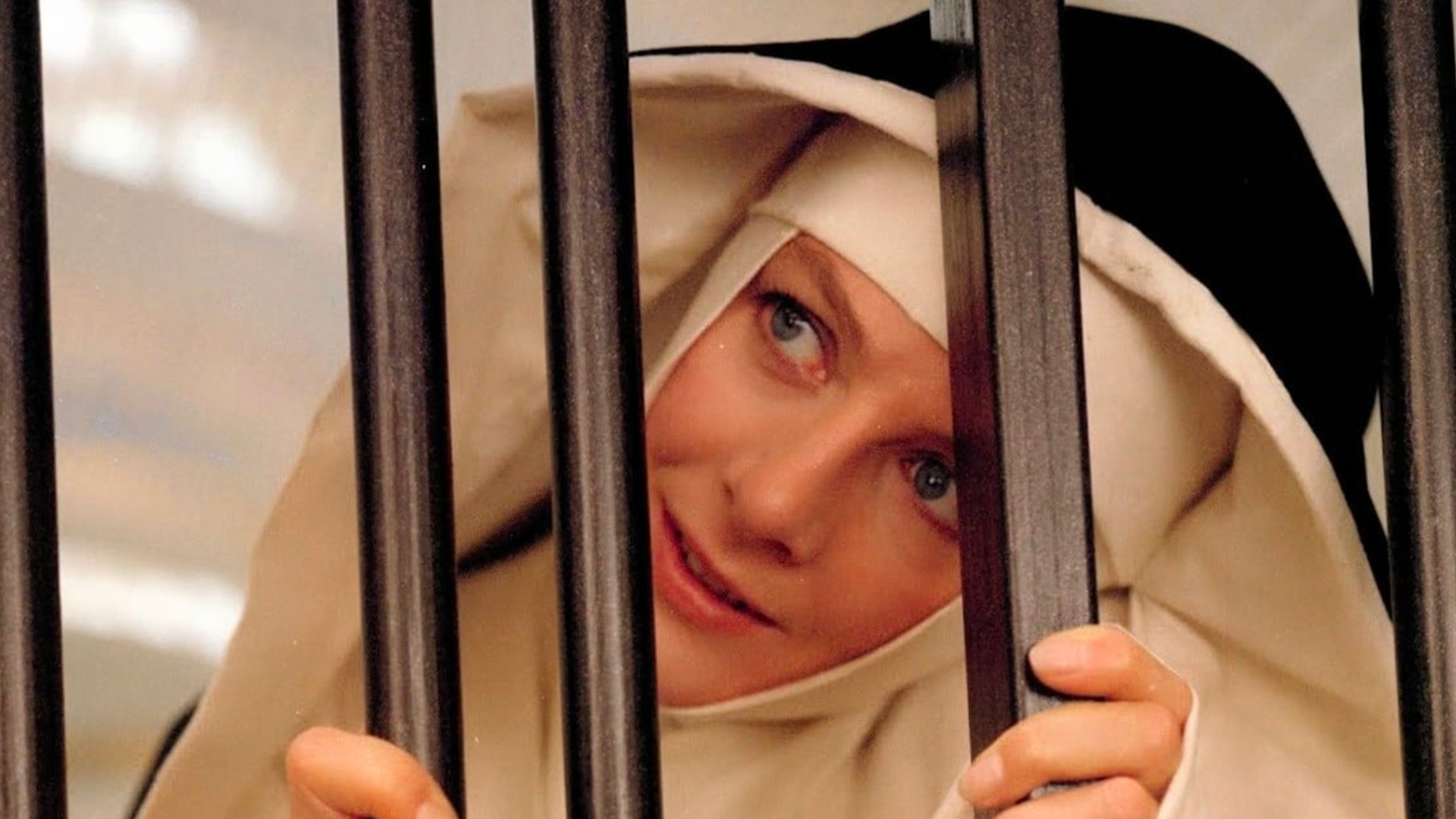
In one of the best scares in The Conjuring universe, Lorraine Warren (Vera Farmiga) goes after a cloaked figure, knowing the danger that could come from it. Valak (Bonnie Aarons) plays the kind of games that demons love playing on the big screen. The light turns off, music blasts on, and a painting of the demonic nun’s face comes alive. It stresses out Lorraine and makes the movie’s audience squirm until the payoff hits. But women of the cloth have had their sacred image tainted long before Valak. Nuns are seen in comedies, dramas, and a certain Julie Andrews musical. When it comes to “scary nuns,” terrific actresses play tyrants, killers, or the possessed in blasphemous, libidinous plotlines.
A frequent element of these women is how they use their vows as a facade for inner darkness or to hold in repression until it unleashes. The life of a nun with three vows (poverty, chastity, and obedience) should be a simple one, but people aren’t so simple. Body and soul slip into bedlam. They are stern and harsh disciplinaries who will cleanse your spirit with punishments. They can be possessed, abusive, and self-righteous. There is not one way to be a nun-gone-bad, and just as Valak isn’t the first, the demonic entity certainly won’t be the last. Should you open up any one of the blood-stained Holy Bibles from the following movies and TV series, you will discover historical scares, Lovecraftian beasts, and other unconsecrated fears.
Häxan (1922)
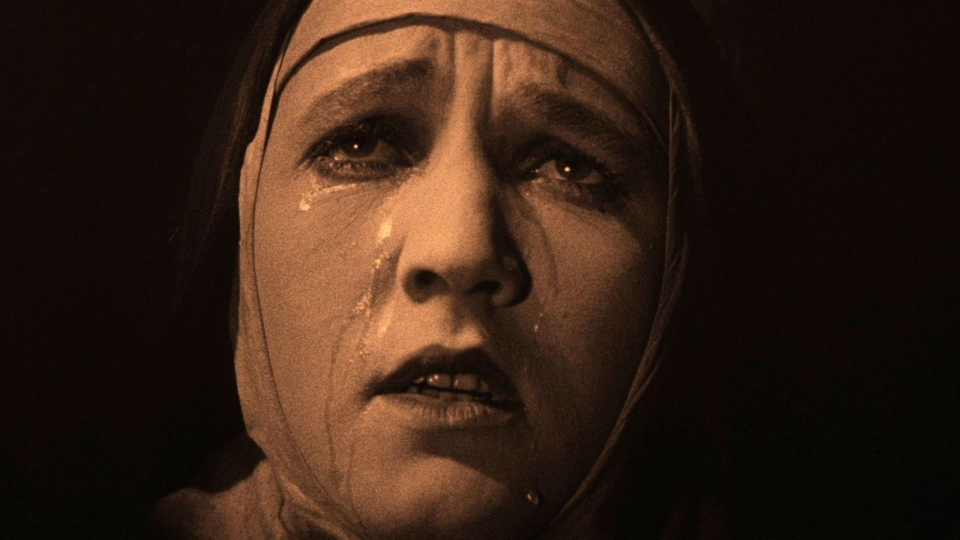
The road to scary nuns goes back to the silent film era. An early predecessor is found in this silent Swedish film that details the history of witchcraft by touching on medicinal roots, devil possession, and how superstitions over the occult persisted into the 1920s, and ultimately, into the modern-day. The film by Benjamin Christensen is remarkable in its compassion by understanding that these persecuted women were victims, not monsters. Told in seven parts, Part 6 is where one nun brings hysteria upon her other sisters.
Sister Cecilia (Clara Pontoppidan) is targeted by Satan and is soon looking out with an unsettling expression where her eyes are dazed and lost, then she stabs a dagger into the communion host. Text appears on-screen, reading, “Often, a single nun was seized by insanity, and suddenly thereafter, the whole convent was overtaken—a mysterious, contagious insanity.” The aftermath of the nun’s desecrating acts causes the other nuns to enter into a frenzied dance as if the Communion wine is spiked. Sister Cecilia’s lost stare and the nuns instigated into a waltz are the opposite of what these figures represent: no order, just chaos.
Black Narcissus (1947)
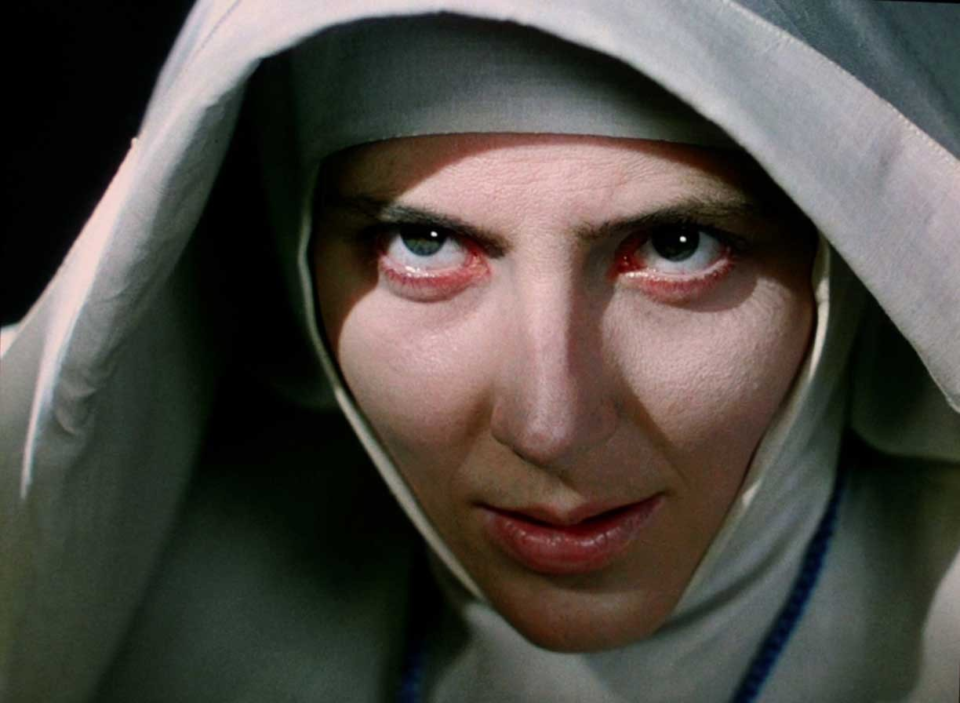
The sweeping, awards-winning melodrama follows a group of nuns who travel far to convert an Indian Raja into a school and hospital. Sister Clodagh (Deborah Kerr) is the strict nun in charge who believes hard work will help what happens to herself and the other nuns. The change in altitude, climate, and culture unravels the women of the convent, but no one suffers a steep decline more than Sister Ruth (Kathleen Byron). She arrives in an already fragile state, which progressively gets worse until it pushes her into a fatal downward spiral. In one scene where it’s clear how much Ruth is losing grip on reality, the camera slowly moves from Clodagh’s hands, over a Bible, to reach Ruth’s chilling face.
Her snow-white habit emphasizes her eyes which are full of contempt and a smile that is lustful for a local man who hardly knows her. The music cue that hits when her face is seen jolts the scene’s energy. Sister Ruth believes Sister Clodagh is out to get her, and denies any kind of help. By the end, Ruth denounces her vows and decides to kill Clodagh. The ex-nun’s face is sweaty, with hateful eyes, and hair falling into her face. Black Narcissus may not exactly be a horror movie, but it veers into that genre. While Sister Ruth takes off the traditional appearance of a nun, the nun’s habit turns into the Grim Reaper’s cloak.
Vertigo (1958)

In this dreamy psychological thriller, Scottie (James Stewart) is unknowingly a witness to a murder plot. He falls into a toxic romance with the accomplice to the crime, Judy (Kim Novak), but the guilty Judy can’t run from her sins. Scottie won’t allow it. He brings her to the bell tower where the murder took place to get the truth out. There, Judy confirms her deception, and right as this damaged couple embraces, a shadowy figure slowly rises from behind Scottie. A frightened Judy backs away, her screams letting everyone know she’s no longer on solid ground.
Like divine justice, it’s revealed to simply be an old nun (Margaret Bacon) checking on the noise. Whether or not Judy falls or jumps isn’t shown, what is clear is how she feels her guilt has manifested into an ominous dark shape, not unlike how Valak could appear. The old nun mutters, “God have mercy,” ringing the bell for a death knell as Scottie stares down at the woman he’s lost.
The Devils (1971)
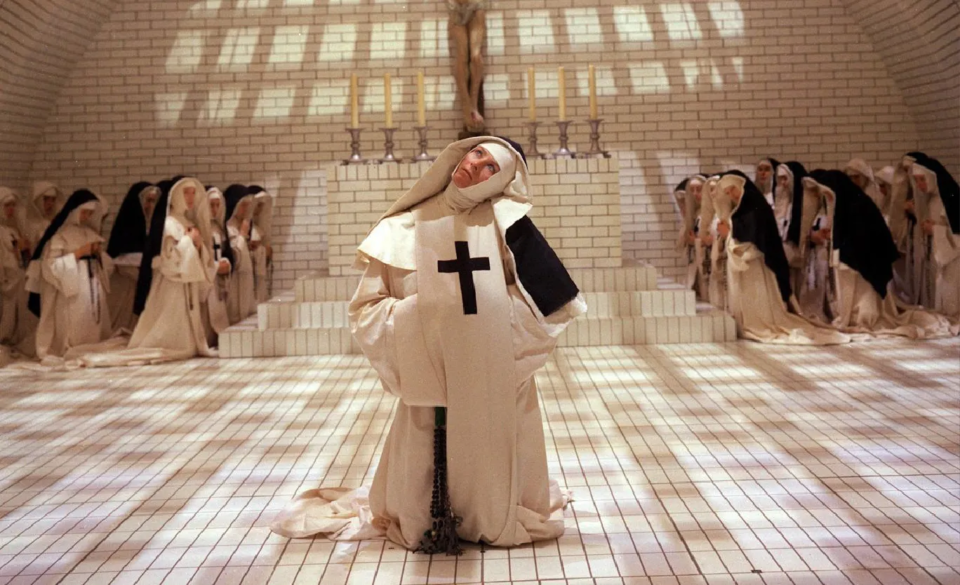
“Nunsploitation” flicks are often unhinged and sexualize these women of the cloth. The Devils (1971) is disturbing when you know how much of what happens is accurate. The events are horrifying, medieval torture and self-interests destroying the French town of Loudun. Sister Jeanne des Anges (Vanessa Redgrave) is a hunchbacked abbess at Loudun’s convent, lusting after Father Grander (Oliver Reed), the local, reckless priest. She chastises fellow nuns for trying to spot him outside, while she has intense sexual fantasies in a hideaway spot for her personal view.
The barred windows of the convent are supposed to protect the holy women from the outside, but in this case, it barely protects the outside from Sister Jeanne. Her fantasy turns Father Grandier into a Christ-like figure, who walks on water to approach her, but even in her fantasies, she cannot escape having her body ridiculed. She cracks under repression, desperation, and releases with no mercy.
Learning Grandier secretly wed a woman, Sister Jeanne berates the bride out of jealousy, shouting, “Fornicator! Sacrilegious bitch!” Vanessa Redgrave gives a demented performance, giggling at inappropriate times, and caressing a ring of keys as her body is unable to contain her sexual urges. She accuses Grandier of demonic possession and is, herself, subjected to torturous methods to “confirm” the claims, but this doesn’t redeem Sister Jeanne or open her eyes to how destructive the overseeing patriarchal rule is.
Grandier is no saint, but his fate is cruel, as per history, he is burned at the stake. The hunchbacked abbess is gifted a charred femur bone of Grandier as a mocking reward, and she fulfills her sexual fantasy with it.
Silent Night, Deadly Night (1984)
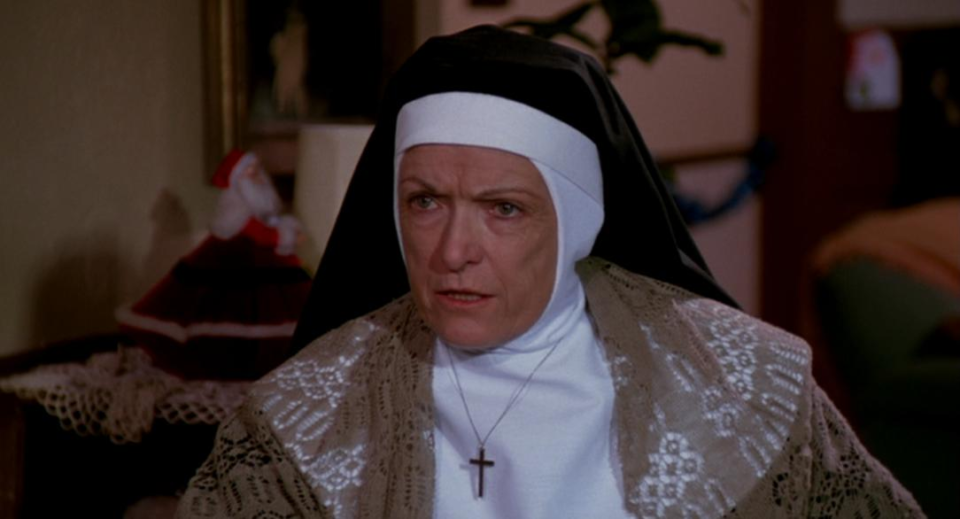
The holiday horror flick depicts the child abuse that Mother Superior (Lilyan Chauvin) inflicts on little Billy (Danny Wagner). “Very, very naughty,” she tells the boy who is struggling with memories of the murder of his parents by a man in a Santa suit. Mother Superior ignores this as the cause for Billy’s behavioral problems each Christmas season. When Billy sees two older kids caught for having sex and beaten by Mother Superior, any healing is thrown out into the cold snow. He’s severely damaged and grows up to become a killer who impales a victim on mounted antlers and beheads a sleigh-riding bully. Silent Night, Deadly Night is a gritty character study, with Billy’s killing spree nowhere near as demented as the head nun who does her part to break him.
A Nightmare on Elm Street: Dream Warriors (1987)
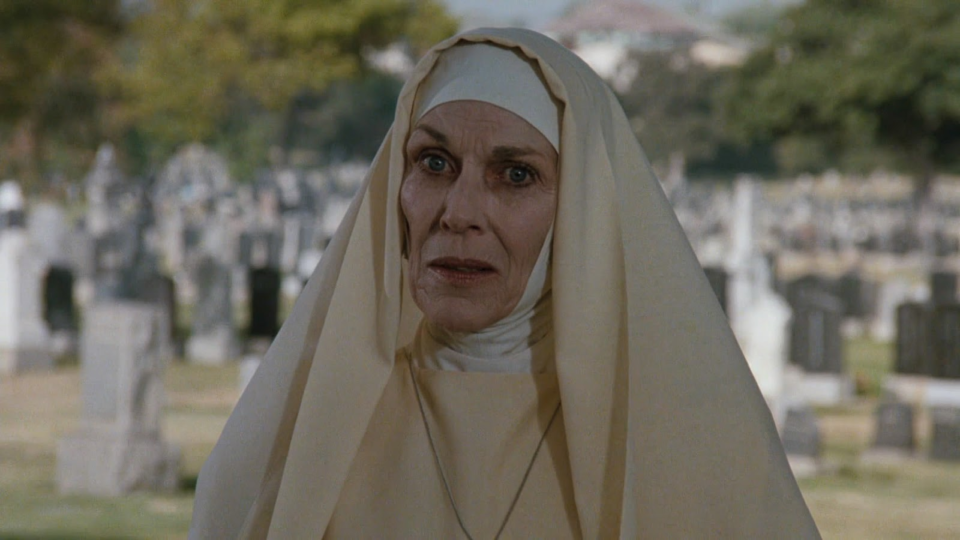
The third installment to A Nightmare on Elm Street is where a nun appears to help defeat Freddy Krueger (Robert Englund). At the central psychiatric hospital, Sister Mary Helena stands in the distance while doctors, nurses, and orderlies move past her. Dressed in a cream-white habit, she delivers warnings about Freddy in later appearances: “The unquiet spirit must be laid to rest. It is an abomination to God and to man.”
Nan Martin’s performance is the opposite of Englund’s. She’s restrained, talking in hushed tones which is effectively disquieting. The otherworldly vibe to this sister is because she’s a restless spirit who was the mother to Freddy. While she is a benevolent character, the ghostly nun has a dark backstory that involves sexual assault which makes her presence unnerving. Then in a creepy image for The Dream Child, Sister Mary Helena (Beatrice Boepple replacing Martin) tries to keep the essence of Freddy in her, but he’s too strong. His arm rips through her stomach and his gloved blades claw out wildly as she tries to hold him in.
Dark Waters (1993)
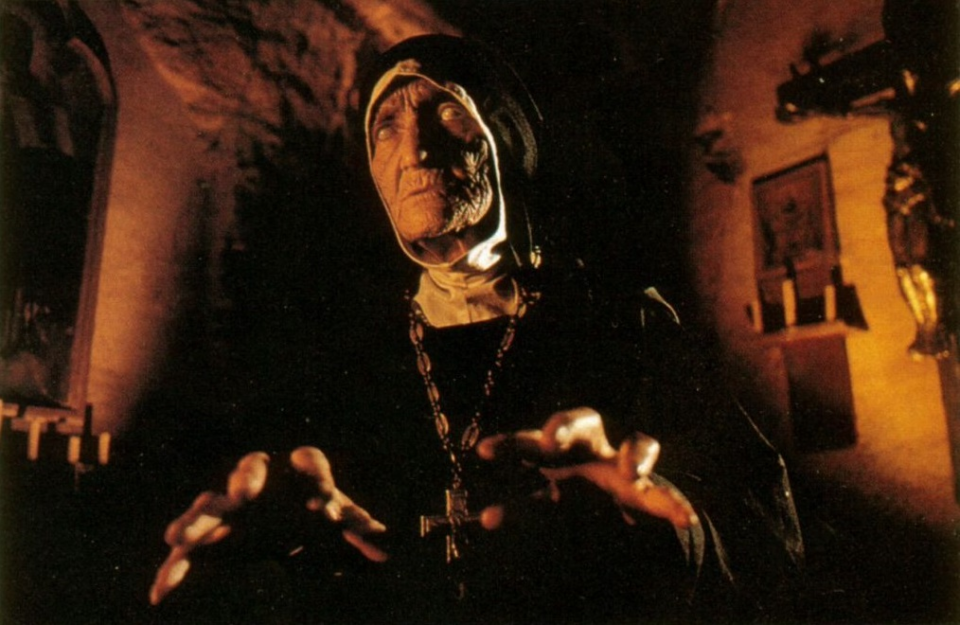
The Devils was released at the early point of nunsploitation movies, whereas this one comes at the end of its peak. “Sometimes secrecy is a blessing,” that couldn’t be more honest when it’s said in this Lovecraftian, seaside horror tale. Water and fire make for a wrathful combo, where a furious rainstorm pelts a mysterious island and on it, a small congregation of nuns holds crosses lit in flames for a mysterious agenda. The island’s rocky land is home to nuns who worship an eldritch being, fiercely guarding their way of life by killing trespassers. Much of the movie relies on a menacing atmosphere, and if the weather and secluded convent aren’t enough, the unholy women act out a Black Mass.
These killer nuns are led by their Mother Superior (Maria Kapnist), a wobbly, blind, old woman who can hardly speak louder than a whisper. This is an island you don’t want to be stuck on.
American Horror Story: Asylum (2012-2013)
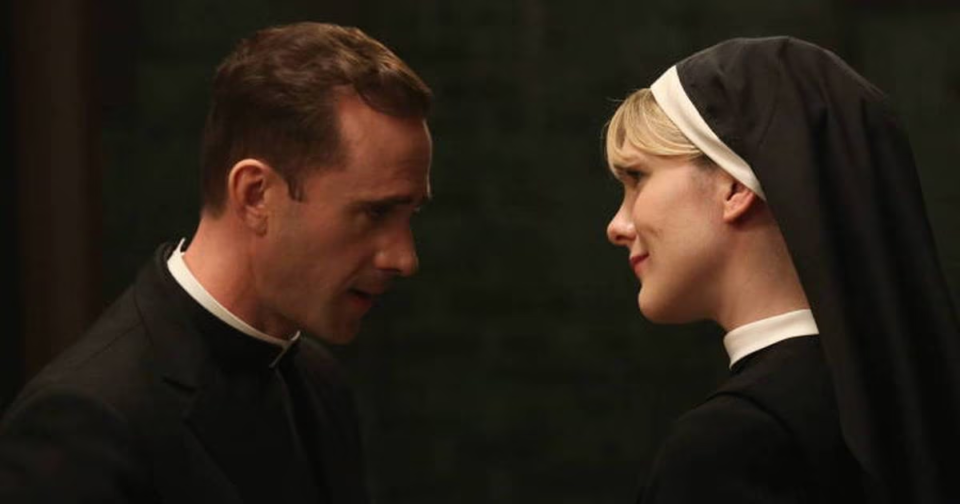
Into the 2010s, American Horror Story introduced audiences to two monstrous women who keep you locked up behind the doors of Briarcliff Manor. The anthology’s second season is a mix of nunsploitation and the AHS brand of excess in horror and shock, remaining the gloomiest, unrelenting entry to this day. In the main location of Asylum, the common room echoes with “Dominique” by The Singing Nun, forever on repeat.
In charge of Briarcliff is Sister Jude (Jessica Lange), who doesn’t believe in mental illness and declares, “All monsters are humans.” Sister Jude has no short list of terrible deeds. She keeps a collection of canes to use on patients when they misbehave, locks away Sarah Paulson’s character under a lie, and has a past that includes a hit-and-run. While Vertigo has a corrupt Judy, Lange’s Judy Martin has her demons too.
She’s a force to be reckoned with, when she isn’t unraveling from guilt. Asylum doesn’t waste any time to dive into how messy and complex Jude is. In a lush, stylized moment that brings to mind Sister Jeanne and her obsession with Father Grandier, Jude lusts after the Monsignor (Joseph Fiennes). She reveals the red lingerie she wears under the coal-black habit and approaches the Monsignor for skin-to-skin contact, only to stir from this fantasy before it gets too hot and heavy.
Häxan taints the Communion bread with a dagger to its center, in American Horror Story, Sister Jude succumbs to a guilty conscience and is driven back into alcoholism, swallowing down every drop of the Communion wine. Yet, she does redeem herself, although it comes at the cost of losing her sanity. Like Silent Night’s Mother Superior, Sister Jude feels like a real threat. This being AHS, Jude isn’t correct when she thinks humans are the worst to exist, not when the Devil can invade.
Sister Mary Eunice (Lily Rabe) is pure and naive, but after the Devil takes over her body, the grisly fun begins. She is lustful, and conniving, killing several individuals, slashing into throats being a favorite tactic. She sexually assaults the Monsignor and punishes the innocent characters locked up at Briarcliff. Sister Mary Eunice dances in front of a cross, having stolen Jude’s red lingerie, and sings to Lesley Gore’s “You Don’t Own Me.” This possessed sister hides in plain sight, loving the mischief and carnage she leaves behind. AHS and Rabe create a great villain, but Jessica Lange’s nun-in-turmoil is captivating in all her flaws. After all, most of the rot in Briarcliff was spreading under Sister Jude’s watch.
Categorized:Editorials

